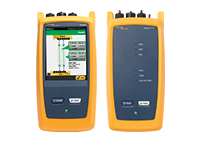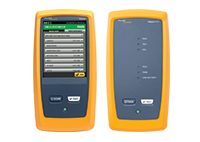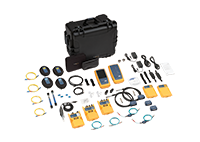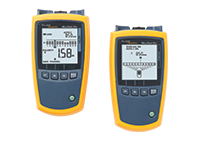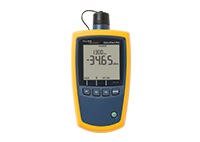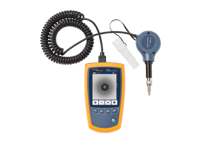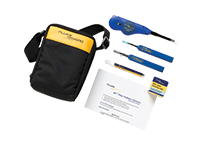白皮书
Standard Compliant Certification & Best Practices
下载 PDF
概述
即使使用检测和清洁光纤端面的行业实践,接头污染仍然是数据中心、校园和其他企业或电信网络环境中造成光纤相关问题和测试失败的主要原因。
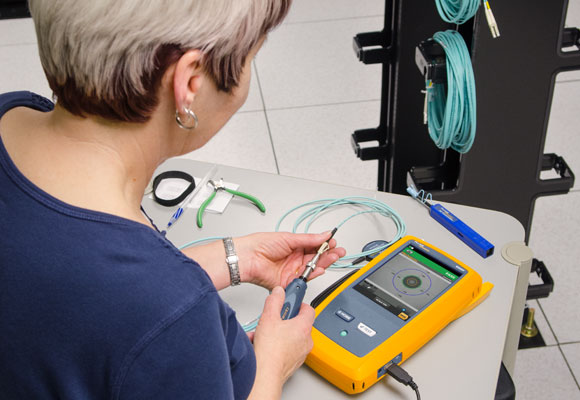
本页内容
Standard Compliant Certification & Best Practices
随着行业的数据速度越来越高、损耗预算越来越严格、以及新的多光纤连接器的出现,主动检测和清洁光纤端面在保证网络运行时间、性能和设备可靠性方面变得比以往更加重要。
Even when users think they have properly cleaned the fiber, every connector endface either field terminated or factor terminated should always be inspected before connecting to a component or piece of equipment. However, relying on subjective human inspection of fiber endfaces often produces inconsistent results.
Thankfully, International Electrotechnical Commission (IEC) industry standards and new innovations enable automatic, consistent and repeatable certification of fiber cleanliness based on specific acceptance criteria.
为性能而清洁
每次安装光纤都应该进行良好的端面清洁。网络性能是由相对较弱的链接决定的,而较弱的链接就是存在光纤端面的地方 —— 这可能是在接线板上、设备端口、或跳接线末端。
无论任何光纤类型、应用或数据速率,光的传输都需要干净的链接路径,包括通过路线上的任何无源连接或接头。纤维芯上的颗粒会造成损耗和反射,导致高错误率和网络性能降级。如图 1 所示的光纤端面污染还会影响昂贵的光纤设备接口,在部分情况下甚至会使设备无法运行。
因为光纤网络是企业的重要资产(数据中心)的核心,另外还要满足客户对随时随地高速访问信息的需求,所以停机和网络性能差是不能容忍的。随着需要更多带宽和传输速度的网络应用继续从 1 和 10 Gbps (千兆/秒) 上升到 40 和 100 Gbps,损耗预算变得比以往更加严格。污垢、灰尘和其它污染物是光纤网络上这些高速数据传输速率的敌人。因此,杜绝所有光纤连接的污染成为避免出现应用性能问题的关键。
With contamination being the single greatest cause of fiber failures, spending the extra few seconds to properly inspect and clean every connector endface will save time and money in the long run.
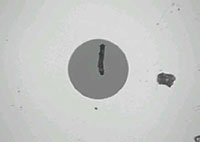
图 1:如这里所示的脏光纤端面会影响网络性能或损坏设备
While accidently touching a fiber endface and working in dirty, dusty construction environments are known causes of contamination, there are plenty of other ways to mishandle fiber that may not be obvious sources of contamination. 以含有体油、线头或其他异物的衣服擦拭端面会导致污染。实际上,即使是最近刚刚清洁过的端面,只要接触周围环境,都会随时受到污染。空气中的灰尘很容易落在端面上,特别是有静电的时候。
每次对接连接器端面时,污染还很容易从一个接口迁移到另一个接口上。即使是用于保护光纤端面的防尘罩也可能成为严重的污染源。遗憾的是,很多用户认为,如果端面之前有防尘罩的保护,那么一定是干净的。但是,没有人能确定防尘罩里的实际情况。即使是工厂端接的新连接器,也是一样的情况。虽然防尘盖可以有效地避免端面受损,但用于制造防尘盖的塑料会因所含增塑剂老化变质而产生残余物,且防尘盖表面可能会包含高速生产过程中使用的脱模物质。所以,如果在刚从包装袋中取出的保护盖上发现端面被污染,请不要感到惊讶。
很多人认为插入设备的端面肯定是干净的,所以拔出后即可毫无问题地重新对接。但是,这经常会导致污染物从一个端面转移到另一个端面上。即使最初的污染在纤维芯之外,对接也可能破坏污染物,导致颗粒从端面上迁移到纤维芯上。设备端口同样如此,这也是经常被忽视的污染源。
检查确认
仅清洁每个光纤端面是不够的。除非使用专用光纤检测工具(例如专业视频显微镜或手持光纤显微镜)检查,否则用户无法知晓端面是否干净。That is why the golden rule is to always inspect, clean and inspect again before connecting.
实际上,端面清洁也会造成污染。每个端面在每次清洁后都应该进行检查。
This is especially a concern for multi-fiber connectors such as the multi-fiber push-on (MPO) style connectors that are rapidly becoming the norm in today’s data center fiber backbone channels as the required interface for 40 and 100 gigabit Ethernet (GbE) applications (see Figure 2).
想象一个 12 光纤 MPO 接口,具有比单光纤连接器大得多的接口区域阵列。清洁这些较大的表面区域时,很容易将一个光纤上的污染物移至同一阵列中的其他光纤。阵列越大,这个风险就越大。对于高密度光纤互联中的 24、48 和 72 光纤 MPO,更多数量的光纤更难以控制,而且并非所有光纤突出的高度都相同。一个多光纤连接器中的光纤高度差异会增加无法正确、一致地清洁每根光纤的风险。
按标准分级和认证
One of industry’s longtime concerns with manually inspecting fiber endfaces for cleanliness has been that determining cleanliness has largely been a subjective and inconsistent process. What one person deems as clean can vary greatly from another person’s point of view. 其他变量,例如技能水平、经验年数、视力、环境光线和使用的光纤检测工具,都会导致光纤端面清洁度确定上的不一致。随着越来越多的光纤网络被越来越多的具体人员安装和维护,可能遇到越来越多的端面清洁度方面经验不足的情况。
In an effort to establish consistency in fiber inspection and achieve more repeatable results for performance across multiple endfaces, the IEC developed 61300-3-35 Basic Test and Measurement Procedures Standard for Fiber Optic Interconnecting Devices and Passive Components. 该标准通过具体的清洁度分级标准来评估光纤端面检测是否能通过认证,从而避免人为的主观因素。
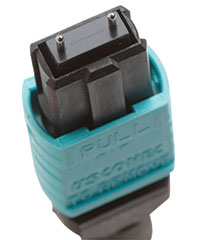
图 2:40 和 100 GbE 应用中必需的 MPO 连接器每次都要进行检查,这是因为难以保证阵列中的所有光纤均已经过正确的清洁。
IEC 61300-3-35 中的认证标准与连接器类型和光纤大小、以及缺陷类型有关。缺陷包含凹点、破碎、划痕、裂纹、颗粒和嵌入的以及松散的碎屑,IEC 标准将其分类为两组 - 划痕和缺陷。Scratches are identified as permanent liner surface features while defects include all detectable non-linear features that can typically be cleaned. Certification to determine pass or fail is based on the number of scratches and defects found in each measurement region of the fiber endface, including the core, cladding, adhesive layer and contact zones, as well as the quantity and size of the scratches and defects (see Figure 3).
For example, as shown in Table 1, multimode fiber with polished connectors can have no scratches greater than 3 μm in width or defects greater than 5 μm in width. 在包层区,没有宽度大于 5 μm 的划痕或缺陷,5 个缺陷的宽度范围在 2 和 5 μm 之间,而宽度小于 2 μm 的缺陷数量没有限制。各个区域允许的划痕和缺陷数量和大小与连接器类型和直径有关。
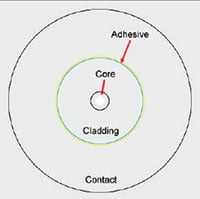
图 3:IEC 61300-3-35 根据端面各个区域中划痕和缺陷的质量和大小对光纤清洁度进行分级。
| 区域 | IEC 61300-3-35 Recommended Acceptance Criteria Multimode Polished Connectors | |
|---|---|---|
| 划痕(给定尺寸的最大数量) | 缺陷(给定尺寸的最大数量) | |
| 核心 |
没有限制 ≤ 3 μm 无 > 3 μm |
4 ≤ 5 μm None > 5 μmm |
|
包层 65 μm to 11 μm |
没有限制 ≤ 5 μm 无 > 5 μm |
没有限制 > 2 μm 5 从 5 μm 至 10 μm 无 > 10 μm |
|
粘接 115 μm to 135 μm |
没有限制 | 没有限制 |
|
接触 135 μm to 250 μm |
没有限制 |
None < 20 μm 50 从 20 μm 至 30 μm 无 > 30 μm |
While the IEC 61300-3-35 standard can be used as a guideline for manually grading cleanliness, a manual procedure would require technicians to determine the size and location of the scratches and defects, which can still introduce human error and inconsistency.
Thankfully automated certification solutions like Fluke Networks’ FI-7000 FiberInspector Pro use algorithmic processes to automatically and quickly inspect, grade and certify fiber endfaces based on the criteria of the IEC standard.
These types of devices eliminate human subjectivity and result in faster, more accurate and repeatable results to help ensure optimum fiber network performance (see the FI-7000, below).
了解要检测和清洁什么
The best answer to the question of what to inspect and clean is everything – every endface should be inspected, and every endface that fails IEC 61300-3-35 certification should be cleaned (see Figure 4). If upon inspection, the endface passes IEC certification, do not clean it. 清洁会因为静电而吸引灰尘。
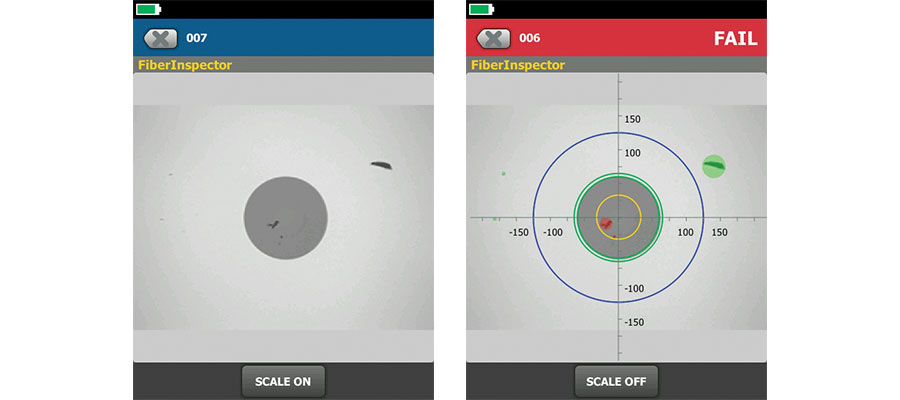
图 4:左侧显示的端面是清洁的还是脏的?自动认证显示,根据 IEC 61300-3-35 和芯中的缺陷,它是脏的。
任何端面,即使是崭新的和工厂端接的插头和尾纤,在对接之前也要进行清洁度检查。这包括光纤测试线、光纤跳接线和预端接主干线的两端。
如果使用适配器对接两个插头,则将其插入适配器之前,两侧的端面和适配器本身的套筒都要接受检查和清洁。光功率计使用的可互换适配器也要定期进行检查和清洁。通常适配器有一个带针孔的遮光罩会累积碎屑。一定要查看测试设备自带的文档,因为部分供应商要求将特定的适配器发回原厂进行清洁。
测试或故障排除任何设备(包括测试仪本身)时,对接之前要检查所有插头和端口。这包括测试设备端口、适配器、测试线端面和所有要连接测试线的端口。
如之前所述,防尘盖和对接也是一种污染源。因为,每次从防尘罩或端口中拔出或取出光纤端面后,在将其插入前都要进行检查并根据需要清洁,即使它是全新的。插入连接器之前一定要检查和清洁端口,即使它是刚刚被拔出的。
Understanding Tools and Consumables
When it comes to cleaning fiber endfaces, there are basically two materials required—wipes and solvent. Canned air and dusters are ineffective for cleaning fiber endfaces as they only succeed in blowing particles around, which simply moves the contaminants to another location. Canned air and dusters cannot effectively clean oils, residues, or small, charged dust particles, and dusters often expel a propellant that can simply become a whole new contaminant to remove.
无绒材料制成的织物或复合抹布具有清除端面污染物所需的吸收能力。通常建议避免使用坚硬表面清洁。When using a wipe or cassette type cleaner, typically one or two short (i.e., 1 cm) strokes on the cleaning material is sufficient. Enough pressure should be applied so that the wipe can conform to the endface geometry and ensure that the entire endface has been cleaned.
When wipes are used alone, it is referred to as “dry cleaning,” which has been proven to be only partially effective in eliminating contaminants. Dry cleaning can also leave a static charge on the endface that can actually attract statically charged dust particles after cleaning.
A better method of cleaning is to use solvents in conjunction with wipes. 溶剂可增加一种化学反应,从而提高抹布清除端面上的颗粒和碎屑的清洁能力,同时避免干式清洁的静电问题。一定要避免使用过量的溶剂,否则会留下一层溶解的污染物膜。To remove excess solvent, wet cleaning should be followed by dry cleaning by either moving to the dry area on the wipe or by following up with new dry wipe. Just be sure to not overdo it to avoid creating static discharge.
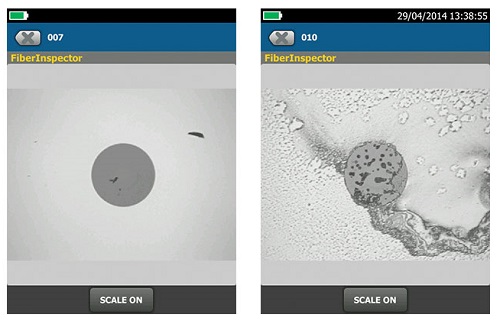
图 5:与可能有残留的 IPA 相比,专用溶剂(左)在清洁端面方面要有效得多。
The solvent itself should also be specially formulated for fiber endface cleaning, such as Fluke Networks’ Fiber Optic Solvent Pen. While isopropyl alcohol (IPA) was used for many years to clean fiber endfaces, specialized solvents have a lower surface tension that makes them far more effective at enveloping debris for removal and dissolving contaminants (see Figure 5). IPA can also leave behind a “halo” as it dries that not only causes attenuation, but also can be difficult to remove. 清洁后不应有溶剂留在端面上。
To clean fiber endfaces inside ports or equipment, specially designed lint-free swabs or mechanical port cleaning devices like Fluke Networks’ Quick Cleaners are used instead of wipes (see Cleaning Kits, below). When using swabs for port cleaning, it is important to apply just enough pressure to clean the endface while rotating the swab several times in one direction. 在端口清洁中使用溶剂时,更重要的是不要使用过量溶剂,以避免插头接口饱和。清洁端口时,清洁剂的蒸发速率关系重大,这是因为很难保证所有溶剂均能完全蒸发。连接时未蒸发的溶剂会保留在接头中,逐渐形成有害的残留物。这是清洁光纤要使用专门配制的溶剂的另一个原因,这些溶剂不但可以滞留足够的时间来发挥作用,也有比 IPA 更快的蒸发速度。
另外一定要记住这些消耗品是一次性的,也就是说清洁端面后的抹布或棉签要立即丢弃。
重用脏抹布或棉签很容易扩散污染。虽然清洁跳线和测试参考线端面很重要,但这些组件也是消耗品,最终都会出故障,如果根据开发商指定的插入次数,这些组件已达到使用寿命,有时候清洁也是不够的。
总结
如果网络运行时间、信号传输性能和设备可靠性对您的业务很重要,则跳过检查和清洁光纤端面可能会产生灾难性的后果。您以为您已正确地进行了清洁,并不表示您可以放弃检查。每次对接(端面和端口)之前,不仅要正确地清洁光纤,还要根据 IEC 61300-3-35 标准仔细检查和认证每个端面。
在过程中使用光纤检测和认证之后,您可避免人为主观性,根据标准快速检查、分级和认证光纤端面。这样应该可以避免因端面污染造成的网络故障。
FI-7000 FiberInspector Pro 自动根据 IEC 标准认证光纤端面
Fluke Networks 的 FI-7000 FiberInspector Pro 只需两秒即可根据 IEC 61300-3-35 行业标准认证光纤端面,提供自动化的通过/失败结果,并避免光纤检测中的人为主观因素和猜测。
FI-7000 FiberInspector Pro 可检测和测量光纤端面上的缺陷,并根据 IEC 61300-3-35 标准自动对结果进行认证,是检测端口内或跳接线上端面的理想选择。为以图形的方式显示哪些缺陷通过或未通过标准要求,FI-7000 的手指缩放触摸屏会以彩色显示各个缺陷并突出缺陷的背景 – 未通过的缺陷显示为红色,通过的缺陷显示为绿色。
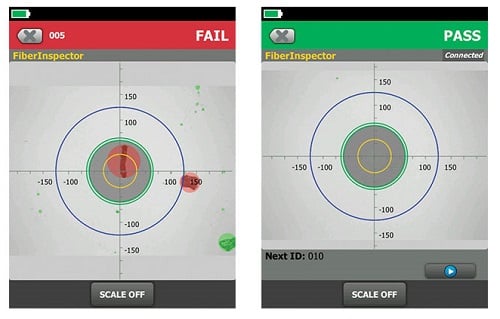
图 6:FI-7000 的认证结果让您能快速判断光纤端面是否通过。
左侧显示了一个未通过的端面,右侧是一个通过的端面。
FI-7000 基于 Fluke Networks 的 Versiv 线缆认证平台而设计,可以将端面图像和认证保存在 Versiv 测试结果中,并可利用 Versiv 的诸多功能,例如使用 ProjX™ 管理工作要求,使用 Taptive™ 用户界面方便地设置,以及使用多功能 LinkWare 软件管理数据和生成专业的测试报告。FI-7000 的通过/失败光纤端面认证可供所有 Versiv 检测相机用户使用,您只需下载最新的 Versiv 固件。
More information at: www.flukenetworks.com/FI-7000
Fluke Networks Fiber Test Solutions
 Versiv™ 系列可加速认证过程中的每一个步骤。着眼未来的设计可支持铜缆认证、光纤损耗、OTDR 测试和硬件升级。革命性的 ProjX™ 管理系统和 Taptive™ 用户界面可确保及时正确地完成作业。分析测试结果并使用 LinkWare 管理软件创建专业的测试报告。
Versiv™ 系列可加速认证过程中的每一个步骤。着眼未来的设计可支持铜缆认证、光纤损耗、OTDR 测试和硬件升级。革命性的 ProjX™ 管理系统和 Taptive™ 用户界面可确保及时正确地完成作业。分析测试结果并使用 LinkWare 管理软件创建专业的测试报告。
Accelerates the fiber certification process with a six second two fiber / two wavelength test. Taptive user interface provides simple, animated guidance to eliminate setup errors.
Enterprise fiber troubleshooting and certification built on the Versiv platform. Taptive user interface simplifies set up, eliminates errors and speeds troubleshooting.
The DSX-5000 CableAnalyzer accelerates every step of the copper certification process with unmatched speed for CAT 6A and Class FA. ProjX management system ensures jobs are done right the first time.
FI-7000 FiberInspector™ Pro 光纤显微摄像机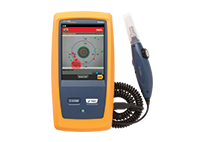
通过 FI-7000 FiberInspector Pro 您可在 2 秒内对端面进行检查和认证,使您首次即可完成工作。自动的通过/失败认证排除了光纤检测中的人为猜测,藉此任何人都可以成为光纤检测专家。
Versiv’s modular design provides flexibility and cost savings. Configure Versiv to meet your exact needs at www.flukenetworks.com/versivconfig
Management – LinkWare™ Live Results Management Service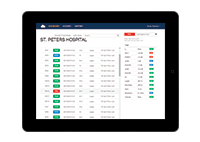
Upload and consolidate Versiv test results from remote sites and track testers and project status from smart devices.
Reporting – LinkWare PC Cable Test Management Software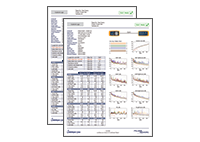
LinkWare 线缆测试管理软件可使您通过单一的 PC 软件应用程序管理来自多个测试仪的所有测试结果。
MultiFiber Pro is the only fiber tester that can test singlemode or multimode MPO fiber trunks without the use of a fan-out cords, eliminating the complexity of polarity issues, and making field testing of cassettes easier.
Easy-to-use Light Source / Power Meter (LSPM) with single-port, simultaneous dual-wavelength feature completes testing in half the time and saves measurements from both wavelengths into one record. 1490 and 1625 nm wavelengths extend product use to broader applications. Store up to 1000 results and upload to LinkWare PC.
Fiber QuickMap™ / Fiber OneShot™ PRO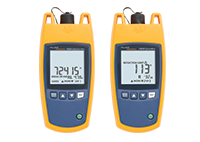
One-button multimode / singlemode fiber troubleshooter locates multiple incidents in the channel in just six seconds to provide full visibility of any potentially problematic links and connections.
VisiFault™ Visual Fault Locator – Cable Continuity Tester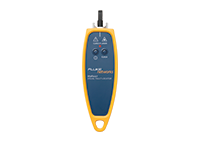
视频故障定位器连通性测试仪可定位光纤、发现故障、验证连通性和极性。
光纤端面检查适用于安装的所有类型的光纤。自动聚焦,提供整齐的微观碎片和端面破损图像。PortBright™ 功能可在黑暗的地方提供照明。
Everything you need to eliminate the #1 cause of fiber optic link failure: 污染。Supports all fiber connector types in datacenter and campus environments including MPO.

